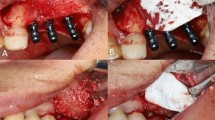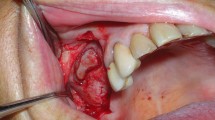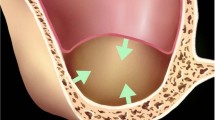Abstract
Objectives
To compare the clinical and radiographic outcomes of two sinus floor elevation techniques: the conventional lateral window technique versus the transalveolar approach using a hydrodynamic ultrasonic device.
Materials and methods
The study was designed as a randomized controlled clinical trial, and participants were randomly allocated to the control group (lateral window: LW) or to the test group (hydrodynamic transalveolar approach: HTA). The intraoperative and postoperative data, including procedure duration and patient-reported outcome measures (PROMs), were collected during the surgery and up to 1 year post-surgery. Additionally, qualitative assessment of gained bone volumes and implant survival rates was recorded.
Results
Twenty-two patients were included in the study. The mean surgical time was significantly longer in the HTA compared to the LW group (48.1 ± 11.2 min vs. 35.2 ± 9.1 min, P = 0.0011). Perforation of the Schneiderian membrane occurred in 2/11 and 5/11 patients in the LW and the HTA group, respectively (P = 0.36). Postoperatively, higher morbidity and consumption of nonsteroidal anti-inflammatory drugs (NSAIDs) were associated with the LW group. However, self-reported satisfaction with surgical procedures was similar in the two groups. At 1 year, implant survival rates of 80% in the HTA group and 100% in the LW group were recorded (P = 0.12).
Conclusions
Although the new transalveolar approach seems to reduce postoperative morbidity, an increased risk of intraoperative complications compared to the LW approach needs to be considered when choosing a technique.
Clinical relevance
Our results provide new insights regarding clinical and radiographic outcomes of HTA and may help further determine indications for its use.
Trial registration
ClinicalTrivals.gov: NCT04499625





Similar content being viewed by others
References
Barone A, Covani U (2019) Maxillary alveolar ridge reconstruction with nonvascularized autogenous block bone: clinical results. J Oral Maxillofac Surg 65(10):2039–2046 https://linkinghub.elsevier.com/retrieve/pii/S0278239107006143
Lambert F, Lecloux G, Rompen E (2010) One-step approach for implant placement and subantral bone regeneration using bovine hydroxyapatite: a 2- to 6-year follow-up study. Int J Oral Maxillofac Implants 25(3):598–606
Sharma A, Rahul GR (2012) Zygomatic implants/fixture: a systematic review. J Oral Implantol 39(2):215–224 https://www.joionline.org/doi/full/10.1563/AAID-JOI-D-11-00055
Starch-Jensen T, Jensen JD (2019) Maxillary sinus floor augmentation: a review of selected treatment modalities. J Oral Maxillofac Res 8(3) https://www.ncbi.nlm.nih.gov/pmc/articles/PMC5676313/
Fan T, Li Y, Deng W-W, Wu T, Zhang W (2017) Short implants (5 to 8 mm) versus longer implants (>8 mm) with sinus lifting in atrophic posterior maxilla: a meta-analysis of RCTs: short implants (5 to 8 mm) versus longer implants (>8 mm). Clin Implant Dent Relat Res 19(1):207–215 http://doi.wiley.com/10.1111/cid.12432
Boyne PJ, James RA (1980) Grafting of the maxillary sinus floor with autogenous marrow and bone. J Oral Surg 38(8):613–616
Pjetursson BE, Tan WC, Zwahlen M, Lang NP (2008) A systematic review of the success of sinus floor elevation and survival of implants inserted in combination with sinus floor elevation. J Clin Periodontol 35(8 Suppl):216–240
Summers RB (1994) A new concept in maxillary implant surgery: the osteotome technique. Compend Newtown Pa 15(2):152 154–6, 158 passim; quiz 162
Fugazzotto PA (2001) The modified trephine/osteotome sinus augmentation technique: technical considerations and discussion of indications. Implant Dent 10(4):259–264
Chen L, Cha J (2005) An 8-year retrospective study: 1,100 patients receiving 1,557 implants using the minimally invasive hydraulic sinus condensing technique. J Periodontol 76(3):482–491 https://onlinelibrary.wiley.com/doi/abs/10.1902/jop.2005.76.3.482
Sforza NM, Marzadori M, Zucchelli G (2008) Simplified osteotome sinus augmentation technique with simultaneous implant placement: a clinical study. Int J Periodontics Restorative Dent 28(3):291–299
Lindhe J, Lang NP, Berglundh T, Giannobile WV, Sanz M (eds) (2015) Clinical periodontology and implant dentistry, 6th edn. John Wiley and Sons, Inc, Chichester, West Sussex; Ames, Iowa
Pal US, Sharma NK, Singh RK, Mahammad S, Mehrotra D, Singh N et al (2012) Direct vs. indirect sinus lift procedure: a comparison. Natl J Maxillofac Surg 3(1):31–37 https://www.ncbi.nlm.nih.gov/pmc/articles/PMC3513806/
Troedhan A, Schlichting I, Kurrek A, Wainwright M (2014) Primary implant stability in augmented sinuslift-sites after completed bone regeneration: a randomized controlled clinical study comparing four subantrally inserted biomaterials. Sci Rep 4:5877 https://www.nature.com/articles/srep05877
Stelzle F, Benner K-U (2011) Evaluation of different methods of indirect sinus floor elevation for elevation heights of 10mm: an experimental ex vivo study. Clin Implant Dent Relat Res 13(2):124–133
Troedhan A, Kurrek A, Wainwright M (2012) Biological principles and physiology of bone regeneration under the Schneiderian membrane after sinus lift surgery: a radiological study in 14 patients treated with the transcrestal hydrodynamic ultrasonic cavitational sinus lift (intralift). Int J Dent 576238:2012 https://www.ncbi.nlm.nih.gov/pmc/articles/PMC3382962/
Troedhan A, Kurrek A, Wainwright M, Schlichting I, Fischak-Treitl B, Ladentrog M (2013) The transcrestal hydrodynamic ultrasonic cavitational sinuslift: results of a 2-year prospective multicentre study on 404 patients, 446 sinuslift sites and 637 inserted implants. Open J Stomatol 03:471 http://www.scirp.org/journal/PaperInformation.aspx?PaperID=41113&#abstract
Temmerman A, Dessel JV, Cortellini S, Jacobs R, Teughels W, Quirynen M (2017) Volumetric changes of grafted volumes and the Schneiderian membrane after transcrestal and lateral sinus floor elevation procedures: a clinical, pilot study. J Clin Periodontol 44(6):660–671 https://onlinelibrary.wiley.com/doi/abs/10.1111/jcpe.12728
Moher D, Hopewell S, Schulz KF, Montori V, Gøtzsche PC, Devereaux PJ et al (2010) CONSORT 2010 Explanation and elaboration: updated guidelines for reporting parallel group randomised trials. J Clin Epidemiol 63(8):e1–e37 https://linkinghub.elsevier.com/retrieve/pii/S0895435610001034
Schwartz-Arad D, Herzberg R, Dolev E (2004) The prevalence of surgical complications of the sinus graft procedure and their impact on implant survival. J Periodontol 75(4):511–516
Shlomi B, Horowitz I, Kahn A, Dobriyan A, Chaushu G (2004) The effect of sinus membrane perforation and repair with Lambone on the outcome of maxillary sinus floor augmentation: a radiographic assessment. Int J Oral Maxillofac Implants 19(4):559–562
Hernández-Alfaro F, Torradeflot MM, Marti C (2008) Prevalence and management of Schneiderian membrane perforations during sinus-lift procedures. Clin Oral Implants Res 19(1):91–98 https://onlinelibrary.wiley.com/doi/full/10.1111/j.1600-0501.2007.01372.x
Khoury F (1999) Augmentation of the sinus floor with mandibular bone block and simultaneous implantation: a 6-year clinical investigation. Int J Oral Maxillofac Implants 14(4):557–564
Stricker A, Voss PJ, Gutwald R, Schramm A, Schmelzeisen R (2003) Maxillary sinus floor augmention with autogenous bone grafts to enable placement of SLA-surfaced implants: preliminary results after 15–40 months. Clin Oral Implants Res 14(2):207–212 https://onlinelibrary.wiley.com/doi/abs/10.1034/j.1600-0501.2003.140211.x
Reiser GM, Rabinovitz Z, Bruno J, Damoulis PD, Griffin TJ (2001) Evaluation of maxillary sinus membrane response following elevation with the crestal osteotome technique in human cadavers. Int J Oral Maxillofac Implants 16(6):833–840
Ardekian L, Oved-Peleg E, Mactei EE, Peled M (2006) The clinical significance of sinus membrane perforation during augmentation of the maxillary sinus. J Oral Maxillofac Surg Off J Am Assoc Oral Maxillofac Surg 64(2):277–282
Viña-Almunia J, Peñarrocha-Diago M, Peñarrocha-Diago M (2009) Influence of perforation of the sinus membrane on the survival rate of implants placed after direct sinus lift. Literature update. Med Oral Patol Oral Cir Bucal 14(3):E133–E136
Aimetti M, Romagnoli R, Ricci G, Massei G (2001) Maxillary sinus elevation: the effect of macrolacerations and microlacerations of the sinus membrane as determined by endoscopy. Int J Periodontics Restorative Dent 21(6):581–589
Pikos MA (1999) Maxillary sinus membrane repair: report of a technique for large perforations. Implant Dent 8(1):29–34
Hernández-Alfaro F, Torradeflot MM, Marti C (2008) Prevalence and management of Schneiderian membrane perforations during sinus-lift procedures. Clin Oral Implants Res 19:91–98 http://doi.wiley.com/10.1111/j.1600-0501.2007.01372.x
Testori T, Weinstein RL, Taschieri S, Del Fabbro M (2012) Risk factor analysis following maxillary sinus augmentation: a retrospective multicenter study. Int J Oral Maxillofac Implants 27(5):1170–1176
Velázquez-Cayón R, Romero-Ruiz MM, Torres-Lagares D, Pérez-Dorao B, Wainwright M, Abalos-Labruzzi C et al (2012) Hydrodynamic ultrasonic maxillary sinus lift: review of a new technique and presentation of a clinical case. Med Oral Patol Oral Cir Bucal 17(2):e271–e275 https://www.ncbi.nlm.nih.gov/pmc/articles/PMC3448305/
Afrashtehfar KI, Katsoulis J, Koka S, Igarashi K (2020) Single versus splinted short implants at sinus augmented sites: a systematic review and meta-analysis. J Stomatol Oral Maxillofac Surg:S2468–S7855. https://doi.org/10.1016/j.jormas.2020.08.013
Younes F, Eghbali A, Goemaere T, De Bruyckere T, Cosyn J (2018) Patient-reported outcomes after lateral wall sinus floor elevation: a systematic review. Implant Dent 27(2):236–245 https://pubmed.ncbi.nlm.nih.gov/29319545/
Acknowledgements
The authors wish to express their gratitude to Professor Adelin Albert and Laurence Seidel for their help in performing the statistical analyses and proofreading.
Funding
The work was supported by the authors’ institution (Department of Periodontology and Oral Surgery, Faculty of Medicine, University of Liege, Belgium). The implants used in this study were received from Nobel Biocare (research grant 2013-1196).
Author information
Authors and Affiliations
Corresponding author
Ethics declarations
Ethics approval
All procedures performed in studies involving human participants were in accordance with the ethical standards of the institutional and/or national research committee and with the 1964 Helsinki Declaration and its later amendments or comparable ethical standards.
Informed consent
Informed consent was obtained from all individual participants included in the study.
Conflict of interest
The authors declare no competing interests.
Additional information
Publisher’s note
Springer Nature remains neutral with regard to jurisdictional claims in published maps and institutional affiliations.
Rights and permissions
About this article
Cite this article
Bacevic, M., Compeyron, Y., Lecloux, G. et al. Intraoperative and postoperative outcomes of sinus floor elevation using the lateral window technique versus the hydrodynamic transalveolar approach: a preliminary randomized controlled trial. Clin Oral Invest 25, 5391–5401 (2021). https://doi.org/10.1007/s00784-021-03847-2
Received:
Accepted:
Published:
Issue Date:
DOI: https://doi.org/10.1007/s00784-021-03847-2




